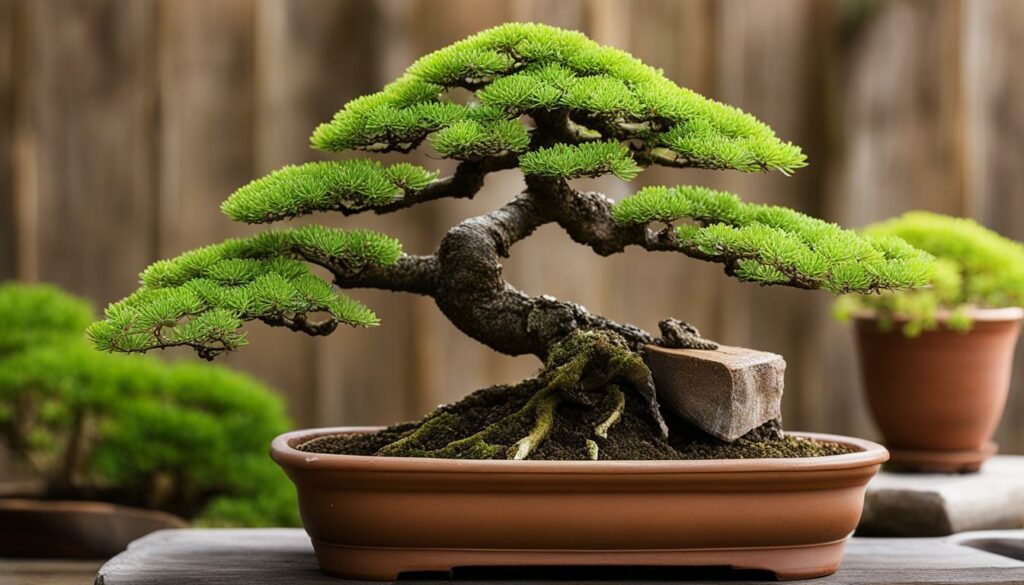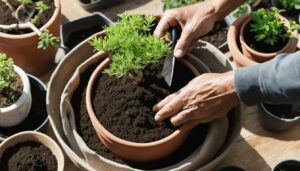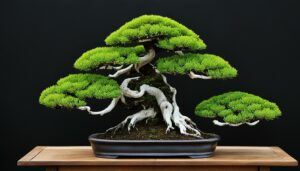Bonsai trees have a unique charm, captivating everyone who encounters them. If you are passionate about cultivating bonsai, you must put in a lot of effort and time to achieve remarkable bonsai specimens. Propagation is an essential aspect of bonsai cultivation and offers an opportunity to create unique miniature trees that will add more beauty to your collection.
Propagation refers to the process of creating new bonsai trees from an existing one. Whether you are just starting with bonsai or an experienced grower, understanding the different propagation techniques is crucial in creating aesthetically appealing bonsai trees. In this section, we will explore techniques used in bonsai cultivation propagation techniques.
Key Takeaways:
- Propagation is a crucial aspect of bonsai cultivation.
- Understanding the different propagation techniques is necessary in creating remarkable bonsai specimens.
- This section highlights various bonsai cultivation propagation techniques for successful bonsai propagation.
- Developing a propagation plan for your bonsai cultivation can increase the success rate.
- Maintaining bonsai health during propagation is critical for successful propagation and growth.
Understanding Bonsai Reproduction
Bonsai reproduction is a fascinating process that involves the propagation of miniature trees to maintain their unique characteristics and aesthetic appeal. To begin, it is important to understand that bonsai can be reproduced using a variety of methods, including cloning, grafting, and layering. Each of these techniques has its own advantages and challenges.
Bonsai cloning involves taking a cutting from a parent tree and rooting it in a soil mixture. This method is ideal for maintaining the specific characteristics of a particular bonsai tree, such as its shape and foliage. However, the success rate of cloning can be lower than other methods, and it requires careful monitoring of the cutting’s growth.
Grafting is another popular method of bonsai reproduction that involves joining two different trees to create a new plant with desirable traits from both parent trees. This technique can be used to add branches, change the direction of growth, or enhance the overall appearance of the bonsai tree.
Layering is a reliable propagation technique that involves creating small, temporary roots along a branch or stem of the parent tree. Once these roots have developed, the branch can be cut and planted, creating a new bonsai tree with the same characteristics as the parent tree.
Overall, understanding the process of bonsai reproduction and the various propagation techniques available is key to successfully cultivating and maintaining these miniature trees.
The Art of Cloning Bonsai
Cloning is a propagation technique that involves creating an exact genetic duplicate of a parent plant. In bonsai cultivation, cloning is often used to maintain the desirable traits and unique characteristics of a specific tree.
The process of cloning involves taking a cutting from the parent tree and rooting it in a growing medium. Once the cutting has established roots, it can be potted and cared for like a regular bonsai tree.
Advantages of Cloning:
- Preserves desirable traits
- Produces an exact replica of the parent tree
- Can be faster than other propagation methods
Challenges of Cloning:
- Requires a healthy and mature parent tree
- May be more susceptible to disease or pests
- Results in limited genetic diversity within your bonsai collection
While cloning can be a useful technique in bonsai propagation, it is important to consider both the advantages and challenges before deciding to clone a tree. Additionally, it should not be the only propagation method used to ensure genetic diversity within your bonsai collection.
To learn more about other bonsai propagation techniques, check out our previous sections on Understanding Bonsai Reproduction, Growing Bonsai from Cuttings, Grafting in Bonsai Propagation, Layering: A Reliable Propagation Technique, and Air Layering for Bonsai Propagation.
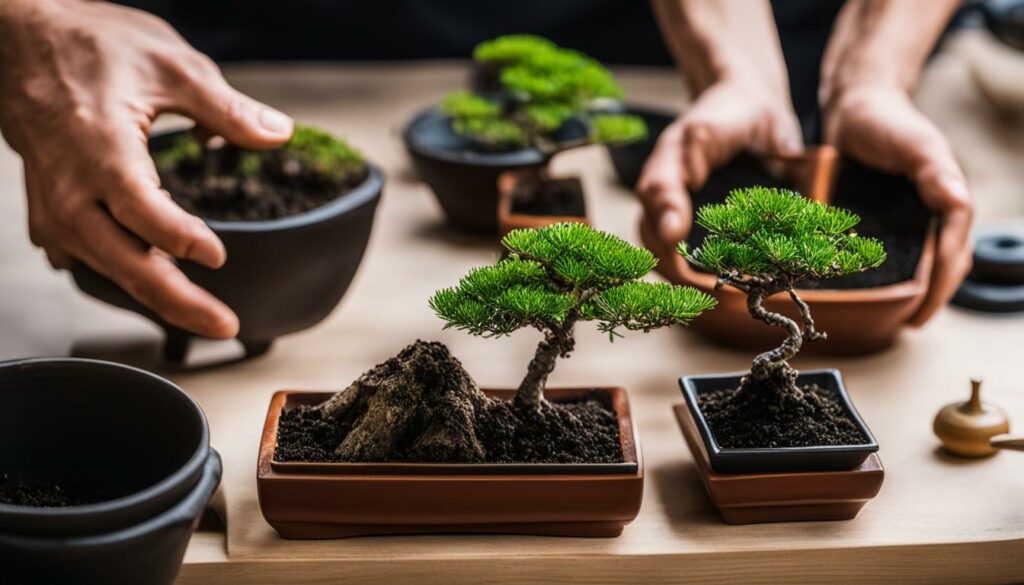
Growing Bonsai from Cuttings
One of the most common propagation methods for bonsai trees is growing them from cuttings. This technique involves taking a cutting from a parent tree and rooting it in soil, allowing it to grow into a new, genetically identical tree.
To successfully grow a bonsai tree from a cutting, follow these steps:
- Choose a healthy parent tree with desirable characteristics for your new bonsai tree.
- Select a branch with a diameter between 1/8 to 3/8 inches and remove it using a sharp, clean pruning shear.
- Remove all the leaves and twigs from the bottom two-thirds of the cutting.
- Dip the cut end of the branch into rooting hormone powder to speed up the rooting process.
- Place the cutting into a container filled with moist soil mix and cover it with a plastic bag to maintain humidity.
- Keep the container in a warm, well-lit area out of direct sunlight.
- Water the cutting frequently to keep the soil moist but not waterlogged.
- After roots have formed, typically after several weeks, move the cutting to a larger container with bonsai soil mix.
- Allow the new bonsai tree to mature and reach the desired size, shaping it as necessary throughout the process.
Growing bonsai trees from cuttings can be a rewarding propagation method, as it allows you to create a new tree with the desirable qualities of a parent tree. However, it requires patience and care to ensure successful rooting and maturation.
Grafting in Bonsai Propagation
Grafting is a propagation method that involves joining two separate plant parts to grow as one whole unit. In bonsai cultivation, this technique is used to produce trees with desirable characteristics, such as strong roots or distinctive foliage.
The first step in grafting is to select the plant material to be used. The scion is the upper part of the plant that will be grafted onto the rootstock, which is the lower part of the plant. It is important to choose scions and rootstocks that are the same species or closely related in order to achieve a successful graft.
Grafting is often used in bonsai cultivation to reproduce a specific tree or to create a new one by combining desirable traits from multiple trees. Some of the benefits of grafting in bonsai cultivation include the ability to accelerate tree growth, improve resistance to certain diseases, and create unique display options.
However, grafting in bonsai propagation also has its considerations. For example, it requires a high level of skill and precision, and mistakes can result in failed grafts. Additionally, grafting is generally a more aggressive method of propagation, and it can be stressful for the tree.
In order to successfully graft a bonsai tree, you need to understand the techniques involved and the specific requirements of the species you are working with. With patience and practice, grafting can be a valuable tool for achieving your ideal bonsai tree.
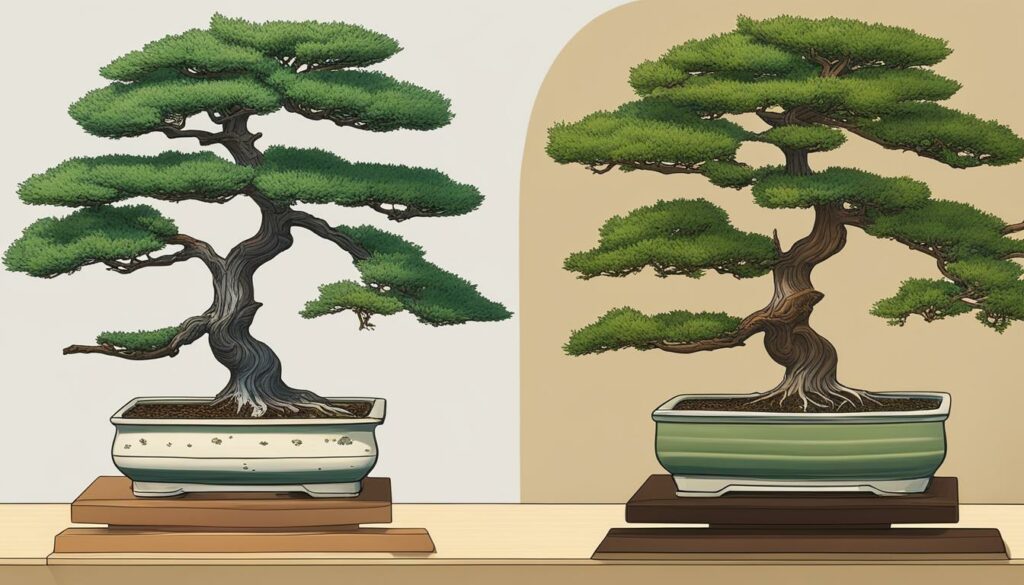
Layering: A Reliable Propagation Technique
Layering is a popular propagation method in bonsai cultivation and involves creating a new tree from an established one. Using this technique, you can produce a new tree with the same unique characteristics as the parent tree.
Layering works by bending a low branch of the parent tree and securing it to the ground or a pot of soil. You then wait for roots to form from the branch before separating it from the parent tree and planting it in its own pot. Layering is a reliable propagation method for species that are difficult to root from cuttings or grafting.
Some of the benefits of layering include a higher success rate than other propagation methods, and the ability to produce a mature and established tree relatively quickly. However, layering can take several months to years, depending on the species and method used. It is important to choose a healthy branch when layering and to provide proper care for the newly established tree to ensure its continued growth and health.
Air Layering for Bonsai Propagation
Air layering is a propagation method that involves creating new roots on a branch while it is still attached to the parent tree. This technique is useful in situations where cuttings do not readily take root, or when you want to create a new plant with existing branches. With air layering, you can create a new bonsai tree with all the same characteristics as the parent tree.
To begin air layering, you will need to choose a healthy branch to work with, similar to the process of selecting a cutting. This branch should be at least one inch in diameter and have a visible leaf node. Once you have chosen a branch, follow these steps:
- Make a shallow cut around the branch, just below the node.
- Wrap damp sphagnum moss around the cut, covering it completely.
- Wrap the sphagnum moss and cut branch with plastic wrap to hold it in place.
- Make sure the plastic wrap is tight and secure to prevent moisture loss.
- Wait approximately four to eight weeks for new roots to form.
- Cut the branch below the new roots and plant in a bonsai pot with well-draining soil.
One advantage of air layering is that you can create a new tree without harming the parent plant. This method is also useful if you want to propagate a specific branch or section of a tree that may not be suitable for other propagation methods. Just make sure to choose a healthy branch and monitor the progress of your air layering regularly to ensure success.
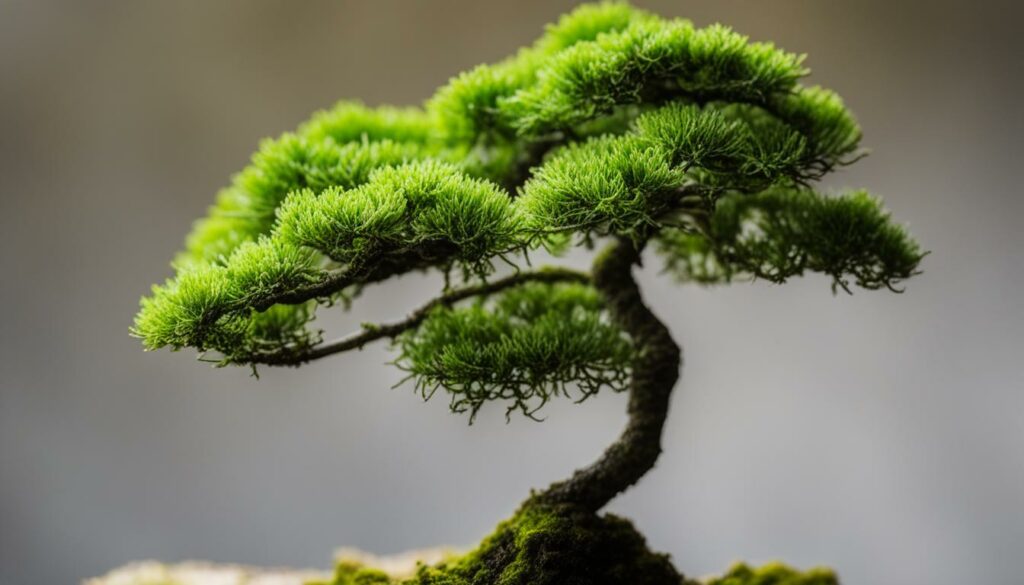
Pro Tip: Air layering can take several weeks or even months to complete, so be patient and keep an eye on your progress. You can also speed up the process by using rooting hormone on the branch before wrapping with sphagnum moss.
Seed Propagation: Starting from Scratch
If you’re looking to create a completely new bonsai tree, seed propagation is the method for you. While it may take longer than other propagation methods, seed propagation allows you to start from scratch and craft a tree that is entirely your own.
Now, it’s important to note that seed propagation can be a bit more challenging than other methods, and success rates can vary. However, with patience and attention to detail, you can successfully grow a beautiful bonsai tree from seed.
The first step in seed propagation is to select high-quality seeds from your desired species of tree. Be sure to research the specific germination requirements for your chosen species, as they can vary widely.
Once you have your seeds, you’ll need to prepare a suitable growing medium and carefully plant the seeds. Keep the soil moist but not waterlogged, and provide ample light and warmth for optimal germination.
It’s also important to note that seedlings will require extra care and attention in the early stages of growth. Be sure to monitor their progress regularly and adjust your care as needed.
Overall, seed propagation can be a rewarding and fulfilling experience for the patient and dedicated bonsai grower. With the right tools and techniques, you can successfully start from scratch and craft your own unique bonsai tree.
Developing a Propagation Plan
Successful bonsai cultivation depends on creating a propagation plan to achieve desired characteristics. Here are key factors to consider:
- Tree species: Choose a species that is well-suited to your climate and the size you want to achieve.
- Desired characteristics: Identify the aesthetic features you want your bonsai to have, such as leaf size, branch structure, and trunk thickness.
- Propagation method: Select a propagation method that aligns with your skills, timeframe, and resources. Consider the different techniques covered in this article, such as cloning, grafting, and seed propagation.
- Tools and materials: Collect the necessary tools and materials for your chosen propagation method, such as root hormone, pruning shears, and soil mix.
- Timeline: Determine a timeline for each phase of your propagation plan, from selecting parent trees to transferring your miniature tree to a bonsai pot.
- Monitoring: Regularly monitor your bonsai’s growth progress, watering and feeding appropriately, and adjusting as needed.
By thoughtfully developing your propagation plan, you can effectively cultivate your bonsai and achieve the desired aesthetic characteristics.
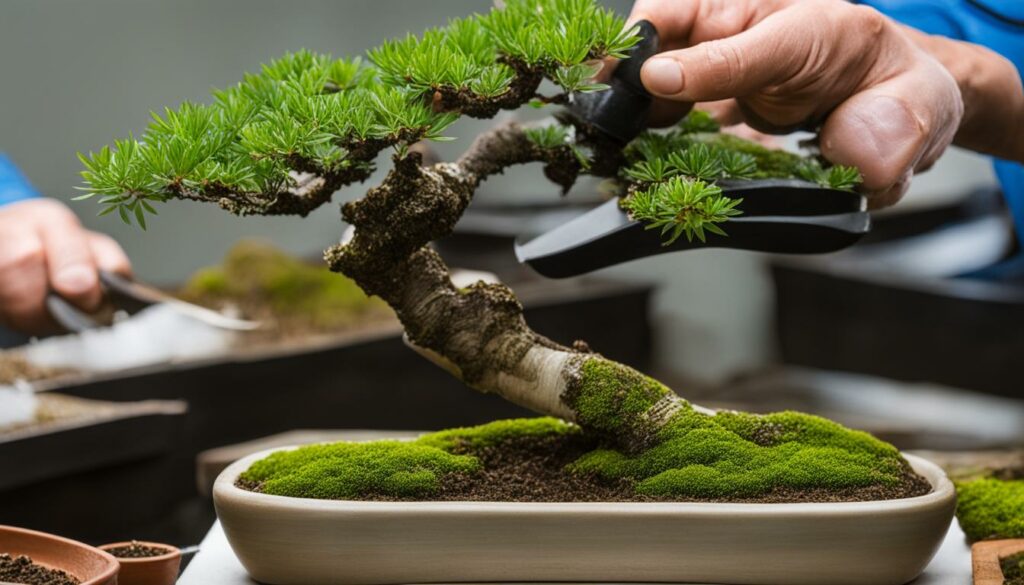
Essential Tools for Bonsai Propagation
To successfully propagate bonsai trees, you need to have the right tools. Here are some essential tools you’ll need:
| Tool | Function |
|---|---|
| Pruning shears | To trim and shape bonsai trees |
| Grafting knife | To make precise cuts when grafting and propagate desirable characteristics from parent trees |
| Rooting hormone | To encourage root growth and healthy development of new plants |
When using these tools, it’s important to ensure they are sharp and clean to avoid damaging the bonsai tree. Proper care and maintenance of these tools will also extend their lifespan and improve accuracy.
Note: While there are other tools available for bonsai propagation, these three are the most essential for beginners.
Maintaining Bonsai Health during Propagation
As you explore different propagation techniques for your bonsai trees, it’s essential to maintain their health throughout the process. Proper watering, light exposure, and disease prevention are crucial to ensuring successful bonsai cultivation propagation techniques.
Watering
During propagation, it’s important to keep the soil moist but not waterlogged. Overwatering can lead to root rot, which can be detrimental to the health of your miniature trees. Before watering your bonsai, check the soil moisture level by sticking a wooden skewer into the soil. If the skewer comes out dry, it’s time to water your tree.
Light Exposure
Proper light exposure is essential for the growth and development of your bonsai trees. As you propagate your trees, make sure they receive an adequate amount of light for their species. Some species require more shade than others, so it’s essential to research each tree’s particular needs before starting the propagation process.
Disease Prevention
During propagation, your trees may be more susceptible to disease. To prevent the spread of disease, keep your tools and work area clean and sterilized. If you notice any signs of disease or pests, take immediate action to treat the problem before it spreads to other trees.
Troubleshooting Common Propagation Issues
Despite your best efforts in bonsai propagation, issues may still arise. In this section, we’ll cover some of the most common problems that can occur, along with helpful tips for fixing them and preventing future issues.
Root Rot
Root rot can be a major issue in bonsai propagation, leading to a tree’s death if not addressed promptly. To prevent root rot, be sure to use well-draining soil and avoid overwatering. If you suspect root rot, remove the tree from its container and inspect the roots for signs of decay, such as a foul odor or mushy texture. If root rot is present, trim away any affected roots and repot the tree in fresh soil.
Poor Growth
If your bonsai tree is showing signs of poor growth, there may be several factors at play. One common cause is lack of sunlight, so ensure that your tree is receiving sufficient light. Additionally, make sure the tree is not root-bound, as this can hinder growth. If soil conditions are poor, the tree may not be able to absorb nutrients properly, resulting in stunted growth. Consider adding fertilizer to the soil if necessary.
Expert Tip: Be patient! Bonsai propagation takes time and care, and it’s not uncommon to experience setbacks along the way. With diligence and attention, you can overcome common issues and help your bonsai trees thrive.
Branch Dieback
Branch dieback, or the sudden death of a tree’s branches, can be caused by several factors such as infestations, disease, or poor pruning techniques. Inspect your tree thoroughly to identify the cause of the dieback, and take appropriate action to address the issue. This may include removing affected branches, applying pest control measures, or adjusting your pruning techniques.
Irregular Shaping
If your bonsai tree’s shaping is irregular or unbalanced, it may be due to incorrect pruning techniques or poor wire placement. Ensure that you’re using appropriate tools and techniques for pruning and wiring, and take care not to overdo either process. With practice and attention, you can achieve a beautifully shaped bonsai tree.
Expanding Your Bonsai Collection through Propagation
By propagating new bonsai trees from parent trees in your collection, you can increase both the quantity and diversity of your miniature arboreal showcase. To get started, choose a healthy, mature tree with desirable characteristics. Take cuttings or seeds and follow the appropriate propagation technique, such as grafting or layering, to create new bonsai saplings.
To maximize success rates, pay close attention to the parent tree’s growing conditions, such as light exposure and watering frequency, to ensure the cuttings or seeds have the best chance of survival. You can also experiment with combining different propagation techniques to create unique hybrids that highlight new and interesting characteristics in your bonsai collection.
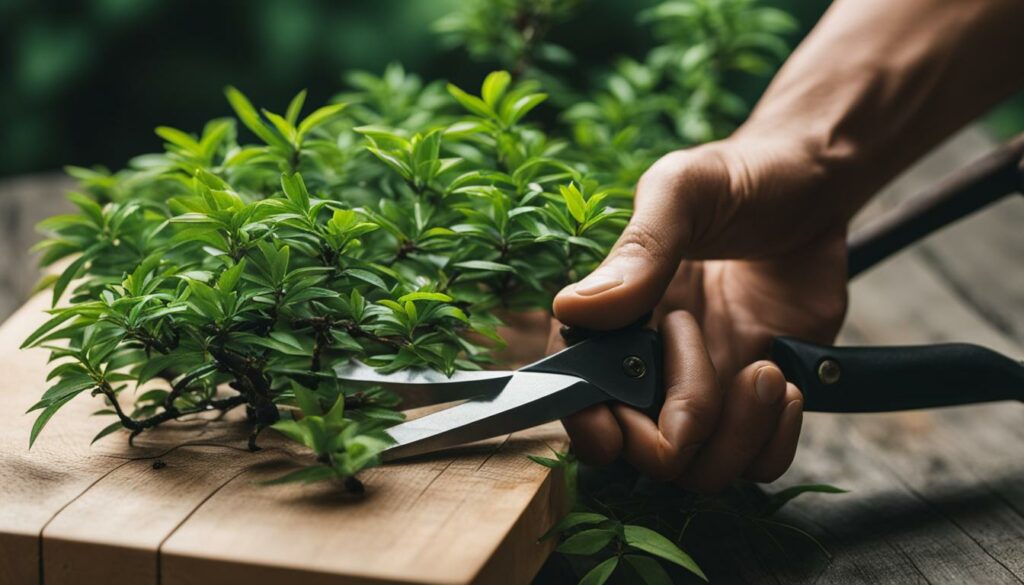
Choosing Parent Trees for Propagation
When selecting parent trees for propagation, consider the overall health of the tree, its aesthetic appeal, and its unique characteristics, such as bark texture or leaf shape. Choose a tree that represents the traits you’d like to see in your new bonsai saplings, while also choosing a species that is well-suited to the climate and growing conditions in your area.
Combining Propagation Techniques
If you’re looking to create truly unique bonsai trees, consider experimenting with different propagation techniques and combining them to create new hybrid saplings. For example, you might use air layering to clone a tree with a desirable trunk shape, then graft on cuttings from another tree with interesting leaf textures.
Bonsai Propagation Success Rates
Remember that not all propagation attempts will be successful, so it’s important to manage your expectations and be patient as your new saplings grow and mature. Keep in mind that some species of bonsai are notoriously difficult to propagate, so it may take some trial and error to find the right method for your specific trees.
Conclusion
Congratulations on taking the first steps towards expanding your bonsai collection through propagation. With the knowledge and techniques outlined in this article, you are well on your way to becoming a successful bonsai cultivator.
Remember, understanding the various propagation methods is essential to nurturing healthy and aesthetically pleasing miniature trees. By developing a propagation plan, selecting the right tools, and maintaining proper bonsai health throughout the process, you can maximize your success rates and grow your collection with confidence.
Whether you choose to clone, graft, or grow from cuttings or seeds, the possibilities for creating unique and beautiful bonsai trees are endless. With patience, dedication, and a willingness to learn, you can enjoy the rewards of bonsai cultivation propagation techniques for years to come.
FAQ
What is bonsai propagation?
Bonsai propagation refers to the process of reproducing and growing miniature trees in the art of bonsai. It involves various techniques for creating new bonsai trees while preserving their unique characteristics and aesthetics.
What are the different methods of bonsai reproduction?
There are several techniques for bonsai reproduction, including cloning, growing from cuttings, grafting, layering, air layering, and seed propagation. Each method has its own advantages and considerations.
What is cloning in bonsai cultivation?
Cloning in bonsai cultivation involves replicating a bonsai tree exactly, ensuring the new tree has the same characteristics as the parent tree. This can be achieved through techniques like stem cuttings or tissue culture.
How can I grow a bonsai tree from cuttings?
Growing bonsai from cuttings involves taking a small section of a mature bonsai tree, treating it with rooting hormone, and then planting it in a suitable medium to encourage root development. With proper care, the cutting will grow into a new bonsai tree.
What is grafting in bonsai propagation?
Grafting is a technique used in bonsai propagation to combine the desirable foliage or branches from one tree onto the root system of another tree. It allows for the creation of bonsai trees with unique characteristics that cannot be achieved through other methods.
What is layering in bonsai propagation?
Layering involves bending a low-lying branch or young shoot of a bonsai tree, securing it to the soil, and encouraging the branch or shoot to develop roots before separating it from the parent tree. This technique allows for the creation of new bonsai trees with established characteristics.
How does air layering work in bonsai propagation?
Air layering is a specific technique where a portion of a branch is removed from the parent tree, treated with rooting hormone, and wrapped in moisture-retaining material. This encourages the branch to develop roots while still attached to the parent tree. Once roots have formed, the branch can be separated and grown as a new bonsai tree.
Can I grow a bonsai tree from seeds?
Yes, seed propagation is a common method in bonsai cultivation. It involves starting a bonsai tree from a seed, providing the opportunity to shape the tree’s growth from its earliest stages. However, it requires patience and time as bonsai trees grown from seeds take several years to develop and mature.
What tools do I need for bonsai propagation?
Essential tools for bonsai propagation include pruning shears, grafting knives, rooting hormone, wire for shaping, and a suitable growing medium. These tools help ensure precision and success in the propagation process.
How can I troubleshoot common propagation issues in bonsai?
Common propagation issues in bonsai include root rot, poor growth, and pest infestations. To troubleshoot these issues, it’s important to address underlying causes such as improper watering, inadequate light or airflow, or nutrient deficiencies. Applying appropriate remedies and adjustments will help restore the health of the bonsai tree.
How can bonsai propagation help expand my collection?
Bonsai propagation allows you to create new bonsai trees with desired characteristics, thereby expanding your collection. By selecting parent trees with unique traits and using effective propagation techniques, you can maximize the number and variety of bonsai trees in your collection.
